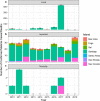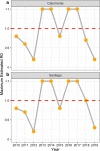Updates on malaria epidemiology and profile in Cabo Verde from 2010 to 2019: the goal of elimination
- PMID: 33097051
- PMCID: PMC7585190
- DOI: 10.1186/s12936-020-03455-7
Updates on malaria epidemiology and profile in Cabo Verde from 2010 to 2019: the goal of elimination
Abstract
Background: Located in West Africa, Cabo Verde is an archipelago consisting of nine inhabited islands. Malaria has been endemic since the settlement of the islands during the sixteenth century and is poised to achieve malaria elimination in January 2021. The aim of this research is to characterize the trends in malaria cases from 2010 to 2019 in Cabo Verde as the country transitions from endemic transmission to elimination and prevention of reintroduction phases.
Methods: All confirmed malaria cases reported to the Ministry of Health between 2010 and 2019 were extracted from the passive malaria surveillance system. Individual-level data available included age, gender, municipality of residence, and the self-reported countries visited if travelled within the past 30 days, therby classified as imported. Trends in reported cases were visualized and multivariable logistic regression used to assess risk factors associated with a malaria case being imported and differences over time.
Results: A total of 814 incident malaria cases were reported in the country between 2010 and 2019, the majority of which were Plasmodium falciparum. Overall, prior to 2017, when the epidemic occurred, 58.1% (95% CI 53.6-64.6) of infections were classified as imported, whereas during the post-epidemic period, 93.3% (95% CI 86.9-99.7) were imported. The last locally acquired case was reported in January 2018. Imported malaria cases were more likely to be 25-40 years old (AOR: 15.1, 95% CI 5.9-39.2) compared to those under 15 years of age and more likely during the post-epidemic period (AOR: 56.1; 95% CI 13.9-225.5) and most likely to be reported on Sao Vicente Island (AOR = 4256.9, 95% CI = 260-6.9e+4) compared to Boavista.
Conclusions: Cabo Verde has made substantial gains in reducing malaria burden in the country over the past decade and are poised to achieve elimination in 2021. However, the high mobility between the islands and continental Africa, where malaria is still highly endemic, means there is a constant risk of malaria reintroduction. Characterization of imported cases provides useful insight for programme and enables better evidence-based decision-making to ensure malaria elimination can be sustained.
Keywords: Imported infections; Prevention of reintroduction; Surveillance.
Conflict of interest statement
The authors declare that they have no competing interests.
Figures




Similar articles
-
Achievement of malaria pre-elimination in Cape Verde according to the data collected from 2010 to 2016.Malar J. 2018 Jun 19;17(1):236. doi: 10.1186/s12936-018-2376-4. Malar J. 2018. PMID: 29914468 Free PMC article.
-
Imported Plasmodium falciparum and locally transmitted Plasmodium vivax: cross-border malaria transmission scenario in northwestern Thailand.Malar J. 2017 Jun 21;16(1):258. doi: 10.1186/s12936-017-1900-2. Malar J. 2017. PMID: 28637467 Free PMC article.
-
Epidemiology of Imported Malaria Cases in Japan, 2006-2014: A Sentinel Traveler Surveillance Approach.Am J Trop Med Hyg. 2017 Nov;97(5):1532-1539. doi: 10.4269/ajtmh.17-0171. Am J Trop Med Hyg. 2017. PMID: 29140229 Free PMC article.
-
Characterization of Plasmodium falciparum and Plasmodium vivax recent exposure in an area of significantly decreased transmission intensity in Central Vietnam.Malar J. 2018 Apr 27;17(1):180. doi: 10.1186/s12936-018-2326-1. Malar J. 2018. PMID: 29703200 Free PMC article.
-
Detecting imported malaria infections in endemic settings using molecular surveillance: current state and challenges.Front Epidemiol. 2025 Feb 26;5:1490141. doi: 10.3389/fepid.2025.1490141. eCollection 2025. Front Epidemiol. 2025. PMID: 40078574 Free PMC article. Review.
Cited by
-
Imported malaria in Cabo Verde (2010-2024): Risks to post-elimination stability.PLOS Glob Public Health. 2025 Jun 12;5(6):e0004592. doi: 10.1371/journal.pgph.0004592. eCollection 2025. PLOS Glob Public Health. 2025. PMID: 40504790 Free PMC article.
-
Antimalarial and Cytotoxic Activity of Native Plants Used in Cabo Verde Traditional Medicine.Plants (Basel). 2023 Feb 20;12(4):963. doi: 10.3390/plants12040963. Plants (Basel). 2023. PMID: 36840311 Free PMC article.
-
Long term monitoring and adaptive strategies: lessons from Hainan's malaria elimination and prevention efforts.BMJ. 2025 Apr 22;389:e080657. doi: 10.1136/bmj-2024-080657. BMJ. 2025. PMID: 40262817 Free PMC article.
-
Situational analysis of malaria in Cabo Verde: From endemic control to elimination, history, cases data and challenges ahead.PLOS Glob Public Health. 2025 Jan 10;5(1):e0004153. doi: 10.1371/journal.pgph.0004153. eCollection 2025. PLOS Glob Public Health. 2025. PMID: 39792907 Free PMC article.
-
Factors related to human-vector contact that modify the likelihood of malaria transmission during a contained Plasmodium falciparum outbreak in Praia, Cabo Verde.Front Epidemiol. 2022 Nov 25;2:1031230. doi: 10.3389/fepid.2022.1031230. eCollection 2022. Front Epidemiol. 2022. PMID: 38455281 Free PMC article.
References
-
- WHO. Eliminating malaria. Geneva: World Health Organization; 2016. https://www.who.int/malaria/publications/atoz/eliminating-malaria/en/. Accessed June 2020.
-
- WHO. Global technical strategy for malaria 2016–2030. Geneva: World Health Organization; 2015. https://www.who.int/malaria/areas/global_technical_strategy/en/. Accessed June 2020.
-
- WHO. World malaria report 2019. Geneva: World Health Organization; 2019. https://www.who.int/publications/i/item/world-malaria-report-2019. Accessed June 2020.
-
- WHO. Countries and territories certified malaria-free by WHO. Geneva: World Health Organization; 2020. https://www.who.int/malaria/areas/elimination/malaria-free-countries/en/. Accessed June 2020.
-
- WHO. Kyrgyzstan receives WHO certification of malaria elimination, 2016. Geneva: World Health Organization; 2020. https://www.who.int/malaria/news/2016/kyrgyzstan-certified-malaria-free/en/. Accessed June 2020.
MeSH terms
Grants and funding
LinkOut - more resources
Full Text Sources
Miscellaneous

